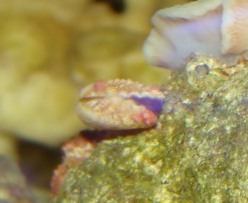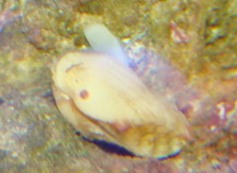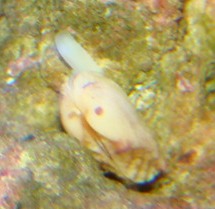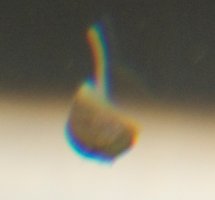|
FAQs about
Brachiopods, Lamp Shells
Related Articles: Marine Invertebrates, Quarantine of Corals and
Invertebrates, Feeding
Reef Invertebrates, Lighting
Marine Invertebrates, Water Flow, How Much
is Enough,
Related FAQs: Marine
Invert.s 1, Marine Invert.s 2,
& FAQs about: Non-Vert IDs 1,
Non-Vert IDs 2, Non-Vert IDs 3, ... Marine Invertebrate Behavior, Marine Invertebrate Compatibility,
Marine Invertebrate Selection,
Marine Invertebrate Systems,
Feeding Reef Invertebrates,
Marine Invertebrate Disease,
Marine Invertebrate
Reproduction, & Marine Plankton,
|

|
|
New critter for IDing 7/18/2010
Good Morning to you all. Bob, love the book!
I have found yet another critter last night with the flashlight.
I believe it to be a bivalve but I want to be sure. I noticed on
your website only a few photos
that look the similar as mine but I would like to be sure.
<This is unusual... as the opening of the apparent valves
appears to be oriented to the surface (rather than away)>
He/she only appears to be active at night and very sensitive to
light. The two sides of the shell open and a white foot
protrudes. At the other end, a darker set of lips, for lack of a
better word, open. It moves by latching the
foot forward and pulling the shell behind. He was spotted on my
live rock.
He disappears during the day (light).
<Good clues>
I only have one other Flaming Clam in the tank and I hope I can
keep this one if he is a healthy addition. Any idea if he will
stay this size, about 1cm in length?
<Likely not to get much larger... I think what you have here
is a Brachiopod>
Thanks again for you and your site!
Dayna Macdonald,
<Please see the Net re the group/phylum name... a rare find.
Bob Fenner>
|
 |
|
Re: New critter for IDing
7/18/10
> Hi Bob,
> I don't think that's a brachiopod. Not if it moves.
Apart from Lingula, I don't believe any of the modern species
move.
<Mmm, most, not all: http://en.wikipedia.org/wiki/Brachiopod>
It looks more like some sort of Arcidae to me, especially the
flat surface across either sides of the gape.
> Cheers, Neale
<Thank you for this... do read again the querior's
description... behaviorally this thing is moving by way of its
"foot"... Arcids are immobile... B>
Re: New critter for IDing, and self-righting lily
leaves 7/18/10
They may be mobile when juveniles, as "spat", and
that's a very small one.
Brachs definitely do not move, not the articulate, epifaunal ones
anyway. I'm certainly not an expert on them, but I have
written one paper on Brachs, and spent my fourth year at
university working on our native species, Terebratulina retusa,
for my final year thesis. A very neat animal. Almost all shell,
virtually no meat, and hence ignored by predators when
they're given choices such as mussels and oysters. These were
fun experiments to run, you'd have enjoyed them.
<Well... let's hope this querior sends in more,
better-resolved/acute image work, input>
> The water lily leaves question was interesting too. I'm
not convinced they are self-righting at all, beyond the tension
of the stem pulling the underside downwards and the aerenchyma in
the leaves pulling the leaf upwards via positive buoyancy.
<Actually... experience shows that these Nymphaeacean leaves
are self-righting... by what mechanism/s I know naught>
I think the fact they aren't self-righting is precisely why
water lilies occur only in still water habitats. In any case,
aquarium specimens are always getting their leaves tangled up and
upside down!
> Cheers, Neale
<And you, B>
|
Re: New critter for IDing
7/19/10
Thanks Bob,
Hello everyone!
<Dayna>
Sorry I only gave you one picture. I am attaching more now. I took
your advise and went through the pages of images on the web for the
Brachiopod. These images look pretty similar only the line pattern
on its shell does not go all the way from one end to the other. It
is also more of an oval shape. You are correct, the opening of the
two sides was observed to be pointed to the surface. Perhaps with
these additional pics you can confirm what it is and if it is a
good or bad addition. I have searched every night since, but cannot
find it
again.
Dayna
<Neale (who is a real paleontologist in the U.K.) thinks this is
likely a true Gastropod, perhaps an Arcid... I'm still sticking
with my guess as a Brachiopod... At any length, this organism is
not harmful, deleterious to your system or livestock. Bob
Fenner> |
  |
|
Re: Critter ID. 6/24/08 Hi, I wish I'd
seen this query - I'd have nabbed it for sure! I saw
something similar to this a couple of days ago while on the hunt
for Tineke's mystery shell/slug/Rhodophyte combo. I'll
see if I can't backtrack and find out what it is. -Lynn
<Thank goodness... I swear I've seen, read about this sort
of "bivalvish", footed, ambulatory marine life... but
can't for the life o me wake up and smell da cacao and recall
what the Dickens group it belongs to. Be chatting! B>
LOL Yep, I know what you mean. Now the trick for me is to
remember where I saw the blasted thing! Take care, -Lynn <Know
whatcha mean... Hey, where are my pants!? Will do. B>
Critter ID: Bivalve Mystery - 6/24/08 Hi there, <Hi
Carl, Lynn here this afternoon!> Firstly congratulations on
the great site! <On behalf of Bob and the crew, thank you very
much!> This is my first marine aquarium and your site has
provided me with a great amount of information to help me on my
way. <Excellent> I was wondering if you could help me
identify this little chap which seems to have hitched a lift on
my last batch of live rock. <Will sure try.> He's only
a few millimeters in size and brown in colour, the main part of
the (shell?) looks like a split seed casing out of which comes a
small white worm. <Okay> It moves by basically attaching
the (head?) end of the worm <The shape is reminiscent of a
clam siphon.> ..to a rock or the glass and then dragging
itself along. It seems to be around day and night and doesn't
seem to be causing any problems in the tank. <That's
always a plus!> Just curious as I've not been able to ID
it.
http://h7lwpw.blu.livefilestore.com/y1p4IDr1MtfX0zR2RucSIySuNcmVaXc7KuxbCiaLHGLht
FTkVWWLqzE8IFbeJTW3-OK_HeGwiouZZhJjzRoDIj7KA/Untitled-1.jpg?download
<Okie doke. Is there any way you can get a higher
resolution/more detailed photo of this little guy? If not,
that's okay. Hopefully, together we can solve this mystery!
When it comes to bivalved critters, the choices that come to mind
are mollusks in the Class Pelecypoda/Bivalvia (clams and such),
Ostracods ('seed shrimps'/Crustaceans), Brachiopods (aka
'lamp shells'), and Opisthobranch sea slugs in the Family
Juliidae. Of these possibilities, the most mobile are the
Ostracods and sea slugs. I think we can rule out Ostracods
because they have multiple long hair-like antennae protruding
from their shells instead of a single, thicker stalk/siphon
(whatever that thing is in the photo). See this example of an
Ostracod for comparison:
http://www.friendsofwarnhamlnr.org.uk/images/pondlife/crustacea/ostracoda/cypris05.jpg
Sea slugs in the genus Juliidae are also out because all have two
obvious rhinophores/antennae on their heads. I don't see any
on your creature and I think you would have noticed them had they
been there. By the way, let me know if you take another look at
your little guy and do indeed see rhinophores! In the meantime,
please see these links for sea slug examples: http://www.seaslugforum.net/display.cfm?id=19650
http://www.seaslugforum.net/factsheet.cfm?base=julizebr
. Now we're left with mollusks/bivalves and Brachiopods. Most
live either attached to hard surfaces or buried in sediments.
Although they're mostly sessile, they can and do move about
when very young (before settling) and, if possible as an adult,
when necessary. Brachiopods attach themselves to hard surfaces
and anchor themselves in the sand by way of what's called a
"pedicle" or stalk. Bivalve mollusks (except for
scallops and such) use a muscular foot to move about/bury
themselves in the substrate, while those that attach themselves
to hard surfaces secrete byssal threads as holdfasts. Now that
you have some of the general terms, please see the criteria
listed below. Hopefully it will help narrow things down. By the
way, if you have a magnifying glass somewhere, dig that puppy out
and take a close look at your little critter. 1. Pedicle that
emerges from a single hole on one side of the shell = Brachiopod.
2. Long, slender pedicle that emerges from what appears to be a
hinged area (where the two shell halves meet) = Brachiopod. 3. A
Muscular foot that emerges from the open side of two shell halves
(not at the hinge) = bivalve/mollusk. 4. Shell with no pedicle
hole + foot/siphon that can completely retract into shell =
bivalve/Mollusc. 5. Once attached to a surface, the creature is
able to pivot about on the stalk/holdfast = Brachiopod. Hopefully
this helps! One thing I'd like to mention is that there may
easily be other possibilities as well that I'm totally
unfamiliar with! As is, I'm inclined to think that what you
have is likely a very young bivalve (mollusk) of some sort trying
to find a place to settle, rather than a Brachiopod. The
reasoning behind this is mainly because the latter is less
common. That and the fact that I can't come up with any other
possibilities! Please see the following links for photos:
Brachiopod (see pedicle):
http://www.dse.vic.gov.au/CA25677D007DC87D/LUbyDesc/WPB-lamp_il/$File/lampshell_il.jpg
Ostracods as well as a photo of a juvenile bivalve (bottom left):
http://www.chucksaddiction.com/hitchpods.html
> Many Thanks, Carl. <You're very welcome. Keep in
touch --Lynn> Bob- I doubt that that is the animal's foot
in the pic of the "bivalve." Could you and Lynn be
thinking of "Lamp shells" (Brachiopoda)? Best,
Sara M.
<Dat's a right>
|
|
 Oh, yeah. B. Oh, yeah. B.
Re: Bivalve mystery . 6/25/08 "Bob- I doubt
that that is the animal's foot in the pic of the
"bivalve." Could you and Lynn be thinking of "Lamp
shells" (Brachiopoda)? Best, Sara M.<Dat's a
right>" Hi Sara and Bob, Yes, a Brachiopod was most
definitely one of the possibilities that came up. I'm hoping
that Carl will be able to determine whether he has a mollusk or a
Brachiopod by the placement, etc, of that slender appendage. It
does indeed look more like a clam siphon or a Brachiopod pedicle
to me than it does a mollusk foot, but after seeing Charles'
photo of a juvenile clam/scallop at the link provided, I had to
admit that the possibility was there (see the photo on the bottom
left: http://www.chucksaddiction.com/hitchpods.html ) . That
still looks like a foot to me because it's a bit broader at
the base, but given the possibility of odd positioning with
Carl's creature and a bit of a blurry photo?? I just
don't know. I'd actually love for it to be a Brachiopod.
Anyway, I'm hoping to hear back from Carl so that we can have
this answered! Take care,
-Lynn
|
|
|

